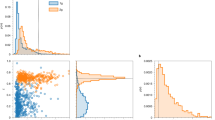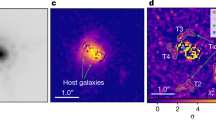Abstract
The current picture of galaxy evolution1 advocates co-evolution of galaxies and their nuclear massive black holes, through accretion and galactic merging. Pairs of quasars, each with a massive black hole at the centre of its galaxy, have separations of 6,000 to 300,000 light years (refs 2 and 3; 1 parsec = 3.26 light years) and exemplify the first stages of this gravitational interaction. The final stages of the black-hole merging process, through binary black holes and final collapse into a single black hole with gravitational wave emission, are consistent with the sub-light-year separation inferred from the optical spectra4 and light-variability5 of two such quasars. The double active nuclei of a few nearby galaxies with disrupted morphology and intense star formation (such as NGC 6240 with a separation6 of about 2,600 light years and Mrk 463 with a separation7 of about 13,000 light years between the nuclei) demonstrate the importance of major mergers of equal-mass spiral galaxies in this evolution; such mergers lead to an elliptical galaxy8, as in the case of the double-radio-nucleus elliptical galaxy 0402+379 (with a separation of about 24 light years between the nuclei)9. Minor mergers of a spiral galaxy with a smaller companion should be a more common occurrence, evolving into spiral galaxies with active massive black-hole pairs10, but have hitherto not been seen. Here we report the presence of two active massive black holes, separated by about 490 light years, in the Seyfert11 galaxy NGC 3393 (50 Mpc, about 160 million light years). The regular spiral morphology and predominantly old circum-nuclear stellar population12 of this galaxy, and the closeness of the black holes embedded in the bulge, provide a hitherto missing observational point to the study of galaxy/black hole evolution. Comparison of our observations with current theoretical models of mergers suggests that they are the result of minor merger evolution10.
This is a preview of subscription content, access via your institution
Access options
Subscribe to this journal
Receive 51 print issues and online access
$199.00 per year
only $3.90 per issue
Buy this article
- Purchase on Springer Link
- Instant access to full article PDF
Prices may be subject to local taxes which are calculated during checkout


Similar content being viewed by others
References
Colpi, M. & Dotti, M. Massive binary black holes in the cosmic landscape. In Advanced Science Letters, Special Issue on Computational Astrophysics (ed. Mayer, L. ). http://arxiv.org/abs/0906.4339 (2009)
Green, P. J. et al. SDSS J1254+0846: a binary quasar caught in the act of merging. Astrophys. J. 710, 1578–1588 (2010)
Civano, F. et al. A runaway black hole in COSMOS: gravitational wave or slingshot recoil? Astrophys. J. 717, 209–222 (2010)
Boroson, T. A. & Lauer, T. R. A candidate sub-parsec supermassive binary black hole system. Nature 458, 53–55 (2009)
Valtonen, M. J. et al. A massive binary black-hole system in OJ287 and a test of general relativity. Nature 452, 851–853 (2008)
Komossa, S. et al. Discovery of a binary active galactic nucleus in the ultraluminous infrared galaxy NGC 6240 using Chandra. Astrophys. J. 582, L15–L19 (2003)
Hutchings, J. B. & Neff, S. G. The double-nucleus galactic merger MKN 463. Astron. J. 97, 1306–1311 (1989)
Mayer, L. et al. Rapid formation of supermassive black hole binaries in galaxy mergers with gas. Science 316, 1874–1877 (2007)
Rodriguez, C. et al. A compact supermassive binary black hole system. Astrophys. J. 646, 49–60 (2006)
Callegari, S. et al. Growing massive black hole pairs in minor mergers of disk galaxies. Astrophys. J. 729, 85. http://dx.doi.org/10.1088/0004-637X/729/2/85 (2011)
Diaz, A. I., Prieto, M. A. & Wamsteker, W. The optical and UV spectrum of the Seyfert type 2 galaxy NGC 3393. Astron. Astrophys. 195, 53–59 (1988)
Cid Fernandes, R. et al. The star formation history of Seyfert 2 nuclei. Mon. Not. R. Astron. Soc. 355, 273–296 (2004)
Levenson, N. A., Heckman, T. M., Krolik, J. H., Weaver, K. A. & Z˙ycki, P. T. Penetrating the deep cover of Compton-thick active galactic nuclei. Astrophys. J. 648, 111–127 (2006)
Kondratko, P. T., Greenhill, L. J. & Moran, J. M. The parsec-scale accretion disk in NGC 3393. Astrophys. J. 678, 87–95 (2008)
Guainazzi, M., Fabian, A. C., Iwasawa, K., Matt, G. & Fiore, F. On the transmission-dominated to reprocessing-dominated spectral state transitions in Seyfert 2 galaxies. Mon. Not. R. Astron. Soc. 356, 295–308 (2005)
Risaliti, G. et al. The XMM-Newton long look of NGC 1365: uncovering of the obscured X-ray source. Mon. Not. R. Astron. Soc. 393, L1–L5 (2009)
Cooke, A. J. et al. The narrow-line region in the Seyfert 2 galaxy NGC 3393. Astrophys. J. Suppl. Ser. 129, 517–545 (2000)
Strohmayer, T. E. & Mushotzky, R. F. Discovery of X-ray quasi-periodic oscillations from an ultraluminous x-ray source in M82: evidence against beaming. Astrophys. J. 586, L61–L64 (2003)
George, I. M. & Fabian, A. C. X-ray reflection from cold matter in active galactic nuclei and X-ray binaries. Mon. Not. R. Astron. Soc. 249, 352–367 (1991)
Fabbiano, G. et al. The time-variable ultraluminous X-ray sources of “The Antennae”. Astrophys. J. 584, L5–L8 (2003)
Maiolino, R. et al. Heavy obscuration in X-ray weak AGNs. Astron. Astrophys. 338, 781–794 (1998)
Elvis, M. et al. Atlas of quasar energy distributions. Astrophys. J. Suppl. Ser. 95, 1–68 (1994)
Magorrian, J. et al. The demography of massive dark objects in galaxy centers. Astron. J. 115, 2285–2305 (1998)
Gandhi, P. et al. Resolving the mid-infrared cores of local Seyferts. Astron. Astrophys. 502, 457–472 (2009)
Schmitt, H. R., Ulvestad, J. S., Antonucci, R. R. J. & Kinney, A. L. Jet directions in Seyfert galaxies: radio continuum imaging data. Astrophys. J. Suppl. Ser. 132, 199–209 (2001)
Miyazawa, G. T. Haba, Y. & Kunieda, H. Broad-band temporal and spectral variation of 36 active galactic nuclei observed with Suzaku. Publ. Astron. Soc. Jpn 61, 1331–1354 (2009)
Fukazawa, Y. et al. Fe-K line probing of material around the active galactic nucleus central engine with Suzaku. Astrophys. J. 727, 19–31 (2011)
Cusumano, G. et al. The Palermo Swift-BAT hard X-ray catalogue. III. Results after 54 months of sky survey. Astron. Astrophys. 524, A64–A101 (2010)
Palmeri, P., Mendoza, C., Kallman, T. R., Bautista, M. A. & Meléndez, M. Modeling of iron K lines: radiative and Auger decay data for Fe II-Fe IX. Astron. Astrophys. 410, 359–364 (2003)
Magdziarz, P. & Zdziarski, A. A. Angle-dependent Compton reflection of X-rays and gamma-rays. Mon. Not. R. Astron. Soc. 273, 837–848 (1995)
Acknowledgements
This work was supported by a NASA grant (with Principal Investigator J.W.). We thank P. Gandhi for discussions on the 13 μm observations. We used the NASA ADS and NED services. This work includes archival Chandra and Hubble Space Telescope data. We acknowledge discussions with T. Di Matteo and L. Mayer at the Aspen Center for Physics 2011 Summer Program.
Author information
Authors and Affiliations
Contributions
G.F. suggested the possibility of double active galactic nuclei, designed the data analysis approach, directed the interpretation of the results and wrote the paper. J.W. is the Principal Investigator of the Chandra proposal, performed the data analysis and participated in the interpretation of the results. M.E. and G.R. contributed to the interpretation of the results and revisions of the manuscript.
Corresponding author
Ethics declarations
Competing interests
The authors declare no competing financial interests.
Supplementary information
Supplementary Information
This file contains Supplementary Test and Data and Supplementary Figure 1 and a legend. (PDF 113 kb)
PowerPoint slides
Rights and permissions
About this article
Cite this article
Fabbiano, G., Wang, J., Elvis, M. et al. A close nuclear black-hole pair in the spiral galaxy NGC 3393. Nature 477, 431–434 (2011). https://doi.org/10.1038/nature10364
Received:
Accepted:
Published:
Issue Date:
DOI: https://doi.org/10.1038/nature10364
This article is cited by
-
From Nearby Low Luminosity AGN to High Redshift Radio Galaxies: Science Interests with Square Kilometre Array
Journal of Astrophysics and Astronomy (2016)
-
A close-pair binary in a distant triple supermassive black hole system
Nature (2014)
-
Menus for Feeding Black Holes
Space Science Reviews (2014)
Comments
By submitting a comment you agree to abide by our Terms and Community Guidelines. If you find something abusive or that does not comply with our terms or guidelines please flag it as inappropriate.



